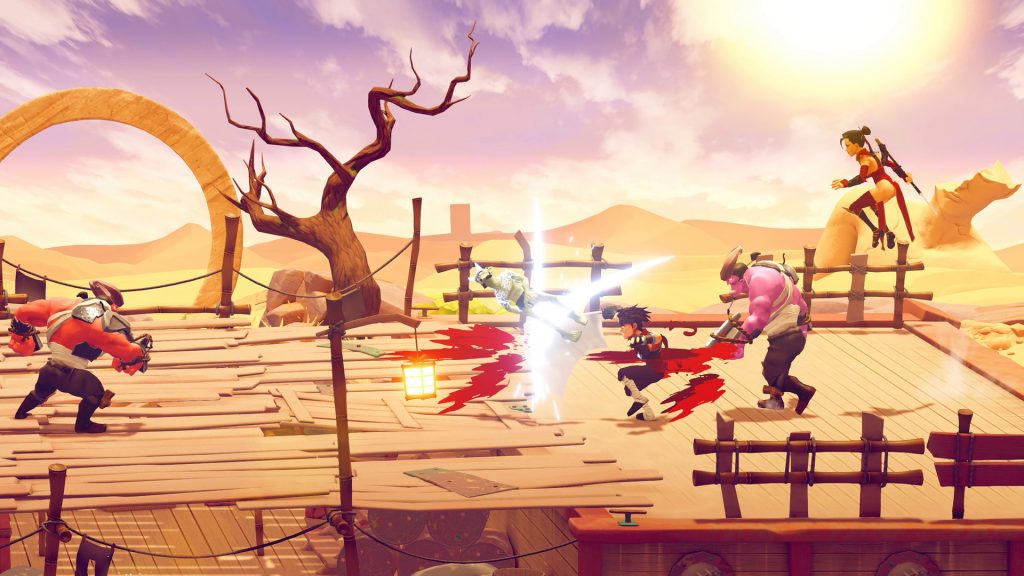Two of the hardest areas to make a successful game in are established genres and defining titles. While it goes without saying any game that is instantly labeled a clone has big shoes to fill, established genres suffer from the idea that a game should be such and such away. This isn’t always bad, generally, if most titles agree on doing it one way, it’s often the best or most successful way to go about it, though over the years many games have shown other ideas can be just as good, if not better, than the traditional ones. Arcade beat ‘em ups have suffered arguably the most, due to the relatively straightforward nature. As we saw with Streets of Rage 4, these ideas can be adapted to modern times and made fun, something Shing! hopes to accomplish. With four characters, crude humor, and a different take on the genre, is it an absolute must for fans, or is it dead on arrival?
There really isn’t much of a plot to Shing!. Essentially, this important item, known simply as the Starseed, was taken and it’s your duty to reclaim it. From here, much of the story deals with establishing the quirky characters, talking about how bad this event is, including the realization it will eventually stop toilets from working, or just a soundboard for Family Guy/Adult Swim-Esque wisecracking heroes. As expected, there will be amusing parts and stuff that fails to land, though this is an experience defined by gameplay.

First and foremost, Shing! has two different sets of controls. The initial one, which was the only one when the PlayStation 4 and earlier version released, use the right thumbstick to coordinate attacks. It actually works surprisingly well, if you take an open mind to it and get a feel for it, though if a more traditional feel is your thing, the second style uses face buttons. These work as expected, with directions and inputs determining what and how you attack. However you choose to play, there is a fair amount of depth from a simple game.
In terms of attacks, each of the four characters have their own advantages and disadvantages, like range, damage and speed, which can be freely combed between or with by simply swapping characters (co-op obviously limits you). Aerial attacks make it easier to juggle, along with different ranges for each attack. As you progress, things get more complicated by introducing different types of enemies.

Initially, all you need to do is pay attention and dodge, but over time there are shielded enemies, along with mobs that are easier dealt with through calculated risks over-aggressive moves. Over time there will be enemies with specific shields, so you can smack their head or legs to do damage and this will swap over time, or shields that require a parry to break. These can get stressful, though Shing! does a good job of riding the line in a reasonable way.
As someone very familiar with extremely intense action games like Devil May Cry or Bayonetta, I was pleased by how forgiving the attack window is. I’d say there is probably a second or so delay, meaning it requires some level of skill to execute, though not it’s not to the point that these moves are not worth it. This is important since these things will make or break your Shing! experience

Once players make it past the initial training levels, there are multiple of the aforementioned specialty enemies. The best way to deal with these enemies is through parries, reflecting attacks, and dodging. At times this can be frustrating like I might reflect an attack that would break a shield and hit a different enemy, though it generally worked fine. If anything, Shing! is more than happy to punish overly eager players through painful attacks and devastating combos.
Outside of the core mechanics, Shing! tries to be more than just a side scroller with mixed success. For example, the first boss can only take sizable damage if you reflect a laser into its eyes and make it eat a blue enemy. The concept is cool, though the execution could use a bit of work. This holds true for most of the more mechanically driven elements too.
On the plus side, Shing! doesn’t focus entirely on the score and instead gives players a variety of tasks needed to fully clear a stage. These include move diversity, damage, and things of the like. This offers a reward for skilled players, with an incentive for less skilled players to get involved, if they’re interested.

Where Shing! starts to fall behind in graphics. Characters, settings, and enemies look really rough. Even the brutal moves where you might slash an enemy in half looks cheesy over brutal. As the world expands, the look doesn’t get much better and, if anything, it becomes pretty obvious how many reused assets are used. It isn’t terrible, though it stops Shing! from having the same polished look similar games feature.
Shing! Review – Verdict
Shing! has some bad, though it’s balanced out with some good. The look, story, and some of the mechanics won’t please everyone, but after about 20 minutes I had no issues having fun. The mechanics might be rough, but they’re fairly accessible and this allows Shing! to feel less like an impossibly hard experience and more a silly game you and a buddy can play without a ton of skill needed to feel like you’re a badass. Naturally, this won’t resonate with everyone, though I think those willing to give Shing! a chance will be pleasantly surprised.
[Editor’s Note: Shing! was reviewed on PlayStation 5 and a copy was provided to us from the publisher for review purposes.]
